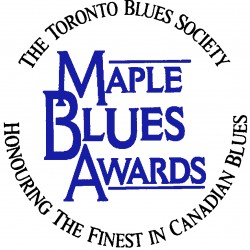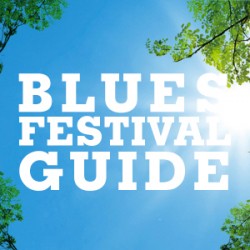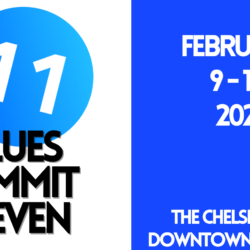Loose Blues News – March 2018
JUNO Nominees:
The JUNO Awards have announced their 2018 nominees. The selections for Blues Album of the Year are: Time to Roll, MonkeyJunk; No Time Like Now, Steve Strongman; Big City, Back Country Blues, Williams, Wayne and Isaak; Better the Devil You Know, Big Dave McLean and Something I’ve Done, Downchild. The winners will be announced on Sunday, March 25 at the Rogers Arena in Vancouver and televised on the CBC . For a complete list of nominees and ticket info go to www.junoawards.ca. Good luck to all!
Lifetime of the Blues Award:
Jerome Godboo was honoured by the Great Lakes Blues Society with the the Jimmy Lewis Award at the recent Firehall Reunion in London. Jimmy Lewis was the house bass player at the Firehall and was an inspiration to other musicians to carry on throughout the challenges that come your way. Karma Productions’ Brian Mortimer (aka Mortz) made the presentation and said “You always have to strive for perfection and show respect for your peers and fans. You must continue to create and push the envelope fearlessly as you present your music. These reasons are why Jerome Godboo was selected this year. Jerome now has a say in future selection of winners along with over 20 previous winners. It’s a nice club to be a part of and we hope Jerome’s career gets a boost because of his unique style and performance and longevity.”
Taiko Drums meet the Blues: In the second concert of their 19th annual season, Canada’s pre-eminent taiko group Nagata Shachu cross boundaries with a genre-bending collaboration featuring Toronto blues artists Ken Yoshioka (harmonica and guitar) and multi-Juno Award winner Julian Fauth (keyboards and vocals) at the Brigantine Room, Harbourfront Centre on Saturday, March 24, 2018. While taiko drumming and the blues could not seem more different on the surface, both are musical genres strongly rooted in rhythm. Taiko master and artistic director Kiyoshi Nagata states, “Although Nagata Shachu has worked with a variety of artists over the years, this is the first collaboration with blues musicians. From our very first rehearsal with Ken and Julian, we knew that this combination was a perfect marriage of rhythm and soul.” Tix at www.harbourfrontcentre.com/boxoffice or phone 416-973-4000, ext. 1.
Songwriting Semi’s:
Montreal Roots & Blues guy Dale Boyle was named a semi-finalist in the International Songwriting Competition. Specifically, the songs “Gasoline” and “My Birmingham” placed in the Americana category. Judges include Tom Waits, Nancy Wilson, Sara Evans, etc. Finalists will be announced in the coming weeks! www.songwritingcompetition.com
Duck Video released:
The Mighty Duck Blues Band have just released a video of “We Will Rock You”, a bluesy take on the rock anthem by Queen. See it on YouTube . From the album “Duck Soup”. Available on iTunes. www.mightyduckbluesband.com
The Blues Bookshelf:
Harmonica master Adam Gussow (who your barely-managing editor had the opportunity to accompany at the Orangeville bluesfest) has published a fascinating blues book called Beyond The Crossroads – The Devil And The Blues Tradition. Mark Thompson President of the Suncoast Blues Society and a member of the Board of Directors for the Blues Foundation has written a comprehensive review and we’re passing it along with permission from www.bluesblastmagazine.com where it was first published.
“Author Adam Gussow is a blues harmonica player who formed Satan & Adam duo with Sterling “Mister Satan” Magee, who played guitar and percussion. They spent years busking on a street corner in Harlem, eventually releasing two albums on the Flying Fish label and taking their music to stages throughout the world. For his first book, Mister Satan’s Apprentice: A Blues Memoir, the writer told the story of the duo’s many adventures.
Currently an associate professor of English and southern studies at the University of Mississippi, Gussow also teaches harmonica and pairs with guitarist Alan Gross in the Blues Doctors duo. For his latest publication, his fifth, the author conducts an in-depth examination of the role of the “devil” in blues music, casting a wide net that moves well beyond the simplistic saint or sinner, good vs. evil impressions one might be left with after a cursory listen to songs like Robert Johnson’s “Hell Hound On My Trail”.
The opening chapter, “Heaven And Hell Parties: Southern Religion and the Devil’s Music,” traces the reactions and responses by clergy and religious leaders over the centuries as they attempt to cope with music’s hold on their flock. Early attempts were made to counteract the fiddle, which could, in the right hands, whip people into a dancing frenzy. The focus then shifted to the guitar players once that instrument began to gain prominence. But the preachers weren’t just motivated to save the souls of their congregation. Money that was spent carousing on Friday and Saturday nights was money that would not find its way into the collection plate on Sunday morning. As the northern migration gained steam in the search for greater economic opportunities and less overtly racist social structures, the African-American churches felt the pinch of funding as membership dwindled. The pastors turned to fire and brimstone, calling out the devil lurking in blues music, hoping to save souls and their financial future. Gussow also reviews the varied responses by the minister fathers towards their son’s musical endeavors, including W.C. Handy, John Lee Hooker, and Big Joe Dushkin. One highlight is a look at a unique “Heaven & Hell” party staged in Clarksdale, MS in 1941 by the local Baptist church as a way to give the youth an opportunity to let their hair down in a controlled environment.
The following section, “The Great Migration And The Urban Dance Hall,” centers on singer Clara Smith’s 1924 recording, “Done Sold My Soul To The Devil”. The song is a dark recitation of a woman’s descent into prostitution, lead on by a sly, grinning man who, too late, is revealed as the devil in human form. Several other versions are recorded, including one by Merline Johnson, “The Yas Yas Girl,” who declares at the finish that she journeyed to hell and shot the devil. Listeners are left to guess which form of the devil she is referring to – or perhaps the devil figure represents an over-riding sense of despair.
The early blues musicians had to be careful with the lyrics and imagery they used in songs so as not to offend any part of the white power structure in the rural South. The author provides guidance for determining meaning beyond the superficial layer songs may present at first hearing. “I’m Going To Marry The Devil’s Daughter: Blues Tricksters Signifying On Jim Crow” is a chapter that presents the white man in a variety of evil guises, as in Lightnin’ Hopkins’ “The Devil Jumped The Black Man”. But the devil image also enabled the musicians to boast of their own power, sexuality, and freedom in a way that escaped notice. Gussow highlights the work of Peetie Wheatstraw, known as “The Devil’s Son-In-Law,” an artist who thoroughly embraced the bold persona laid out in his songs, showing no fear of possible retribution.
The fourth segment, “The Devil’s Gonna Get You: Blues Romance And The Paradoxes Of Black Freedom,” marks the tensions in sexual relationships as African-Americans utilized their freedom to travel and select their partner in the aftermath of slavery. In the early 1920s, female blues singers dominated the marketplace, with Bessie Smith relating a form of sexual servitude on “ You’ve Got To Give Me Some”. Gussow quotes the 1925 Papa Charlie Jackson song, “The Cat Got The Measles,” as an early example of a response of a male musician blaming the devil, Legba, for turning his woman to another man. The Skip James classic, “Devil Got My Woman,” utilizes the devil image in several contrasting ways within the same song, as explanation for human failings plus a general excuse for unexplained actions.
The final section will certainly generate plenty of discussion. “Selling It At The Crossroads: The Lives And Legacies Of Robert Johnson,” takes on the celebrated myth of Johnson’s mystical deal with the Devil at the crossroads. The author’s in-depth research gives him the information to poke holes in the timeline from Johnson’s embarrassing performance in front of Son House to his triumphant return to universal acclaim. The author asserts that it was guitarist Ike Zimmerman, not Legba, who mentored his young protege, turning him into a guitar master after many late night sessions conducted in a local graveyard. Next, the author makes a case for the impact the movie Crossroads had in selling the “devil at the crossroads” tale to wider public, and quite possibly starting the onslaught of white blues guitar players trying to emulate the faster, louder style of Steve Vai’s character. Gussow provides some additional information about the movie’s cast and speculates about what might have been had one of the dueling guitarists been a black blues artist. Finally, he looks at the successful branding of the Crossroads theme by the city of Clarksdale in a concerted effort to establish the area as the center of blues tourism in the Mississippi Delta region. It all comes together at the noted intersection of Hwy 49 and Hwy 61, which Gussow’s research shows did not exist during Robert Johnson’s lifetime.
Also included are extensive Notes and Bibliography sections plus eight pages in chronological order listing blues songs with a devil theme.
Gussow certainly gives blues fans plenty to ponder in this challenging book that doesn’t back away from taking on some cherished parts of the blues tradition. Readers will be compelled to revisit some classic tunes to hear the songs with fresh ears, ready to garner new meanings based on the many forms of the devil illuminated in this work. Thanks to Mr. Gussow for attempting to get us out of our blues comfort zones, and for providing readers with well-researched concepts that invite us to do more than just listen to the music.”










